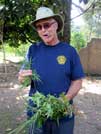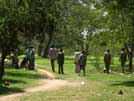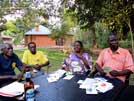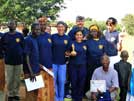

Click on a photo to see a bigger one
By Chuck DuVivier
Nothing was scheduled for us until our afternoon "graduation" ceremony so we all anticipated a quiet and relaxing morning. I decided to spend some time to take a natural history oriented walk with no intention of raising a sweat. First, I went north into the banana grove, then northwest to look at Patrick's young teak trees, then I spent some time under and in a big mango tree. The mango was in full bloom and thousands of bees were visiting it. I observed that in every cluster of flowers there were hundreds and hundreds of individual blossoms being visited by the bees, but older clusters of blossoms only ended up with 2-4 little mango fruits growing. If all those little blossoms had been fertilized and actually developed fruit, the branches would eventually be stripped off the tree because of the weight.
I then walked out to the path on the northwest of Patrick's yard to watch some tethered goats to see what they were eating. They are browsers, not grazers, and were really gobbling down lots of greenery. They liked the grass and were stripping the leaves off every bush within their reach, feed that would be rejected by any cattle or sheep, pig or chicken, but they leave an area still brushy when they are done. Goats that produce twins and triplets for meat have good potential here except the method of tethering them is so labor intensive that they are considered too labor intensive. Although expensive, a good fence or two coupled with larger herds could be all that is needed.
 Walking a bit further, I noticed a small cannabis patch, and since I now had a pretty big bouquet of collected branches, goat browse, grasses, mango flower clusters and more, I decided to pick some cannabis to add to my collection. I then moved over to the north of the well where goats had been tethered several times in the last few days in the hope of seeing what plants were rejected after "intensive" goat feeding pressure. There were some lantanas, thorny acacia bushes and euporbias that seemed mostly untouched but everything else looked pretty harvested. I guess that means if you let goats overuse an area, these agricultural-good-for-nothing plants are all that would survive on your land.
Walking a bit further, I noticed a small cannabis patch, and since I now had a pretty big bouquet of collected branches, goat browse, grasses, mango flower clusters and more, I decided to pick some cannabis to add to my collection. I then moved over to the north of the well where goats had been tethered several times in the last few days in the hope of seeing what plants were rejected after "intensive" goat feeding pressure. There were some lantanas, thorny acacia bushes and euporbias that seemed mostly untouched but everything else looked pretty harvested. I guess that means if you let goats overuse an area, these agricultural-good-for-nothing plants are all that would survive on your land.
 
|
Patrick surprised me. When I showed him the cannabis and told him what it was, he became very upset and wanted to know where I'd found that. He then yelled over to all his family and workers over by the kitchen buildings and everybody got upset and agitated. Before I knew it, he was on the phone calling in the police from Kamuli and despite our pessimism that nothing gets done quickly in Africa, two policemen arrived in about 20 minutes. After asking me to point to where I found it, they cautiously worked their way across the field to investigate and after pulling up all the plants, they returned to hold an inquisition. Witnesses had been arriving to give their testimony and the proceedings went on through lunch and until we had to leave for our afternoon graduation meeting. We heard later that the pot grower was captured and admitted to his crime and was taken to jail in Kamuli.


|
After our return to Patrick's house, I had arranged for a meeting with some of the people whom I felt were the best "green thumb" gardeners in the area. During my farm visits and had been on the lookout for people who clearly liked plants and were willing to experiment and try new things. My wife, Kate, had picked out lots of non-hybrid garden seeds for me to distribute. Our hope was that those that grew well and produced tasty vegetables would then provide seed for further propagation.v
 Patrick and I explained that we wanted the group of four to get together every two weeks to discuss what they were doing in their gardens, how the plantings were growing and to bring vegetables that they produce to show each other. We also encouraged them to keep a calendar/diary of their gardens, to make a garden map and record what they planted and where, when they harvested, how much they liked eating a vegetable and some idea of the how well it yielded. We also explained that they could harvest and save seeds but to avoid cross-breeding, each variety should be planted in isolation from the others. I brought 4 varieties of Okra and they went to four different gardens. We divided up the seeds with a goal of preventing cross-breeding between varieties. They knew most of the vegetables but not all, so some may grow just fine but might not be eaten when they should, just like I had seen amaranth patches being grown but not eaten because their growers hadn't really been sure of what they were growing. The seed packets have nice directions for how to grow the vegetables but nothing about how to prepare and cook them. We'll have to wait until later to hear how well the garden club will do and what influence it can have on the community.
Patrick and I explained that we wanted the group of four to get together every two weeks to discuss what they were doing in their gardens, how the plantings were growing and to bring vegetables that they produce to show each other. We also encouraged them to keep a calendar/diary of their gardens, to make a garden map and record what they planted and where, when they harvested, how much they liked eating a vegetable and some idea of the how well it yielded. We also explained that they could harvest and save seeds but to avoid cross-breeding, each variety should be planted in isolation from the others. I brought 4 varieties of Okra and they went to four different gardens. We divided up the seeds with a goal of preventing cross-breeding between varieties. They knew most of the vegetables but not all, so some may grow just fine but might not be eaten when they should, just like I had seen amaranth patches being grown but not eaten because their growers hadn't really been sure of what they were growing. The seed packets have nice directions for how to grow the vegetables but nothing about how to prepare and cook them. We'll have to wait until later to hear how well the garden club will do and what influence it can have on the community.
By Amanda Wirtz
So many years of planning - Family Planning!
For over 7 years, it has been a dream of mine to support a family planning project in Africa. I trained to be a natural family planning counselor in Switzerland in 2004 where I learned, amongst other things, about a very simple method of monitoring fertility utilizing a string of beads. These beads, called Cyclebeads, were created by some rather ingenuitive folk at Georgetown University; since their genesis, although they can be used in any population - they've been made rather famous by their implementation in indigenous communities with low literacy rates. Uganda was one of many countries to subscribe to their use. Many communities, however, had not received training or information on the beads. Ours was one of them.
I had contacted Georgetown prior to our departure and requested several samples. After compiling a training manual with aids for instruction, I was prepared to teach the community. I learned however, that due to the sensitive nature of sexuality relative to their culture, it was most effective to train the 'gatekeeper' of sorts - the family planning guru and community health education leader. She in turn, would format the education in a culturally appropriate way and disseminate the information.
 It is understandable why everyone loves... and trusts Janet. She has been a health educator and activist of sorts in her community for a long time. Not only is she enthusiastic and endearing, she has a heart to reach out into the community to lift others up. Just spending time with her certainly lifted me. After discussing some of the communities needs and challenges relative to family planning (which were rather complex), I presented my materials. She was so excited to see Cyclebeads... and to learn! We went through the protocol for effective use, various counseling scenarios, and role-played conversations to mimic what she might encounter as an educator. Joanna had requested other family planning materials (aids and information) from San Diego Planned Parenthood (thank you PP!) which were helpful as well. She walked away with training aids and education to impart; I walked away with a dream fulfilled.
It is understandable why everyone loves... and trusts Janet. She has been a health educator and activist of sorts in her community for a long time. Not only is she enthusiastic and endearing, she has a heart to reach out into the community to lift others up. Just spending time with her certainly lifted me. After discussing some of the communities needs and challenges relative to family planning (which were rather complex), I presented my materials. She was so excited to see Cyclebeads... and to learn! We went through the protocol for effective use, various counseling scenarios, and role-played conversations to mimic what she might encounter as an educator. Joanna had requested other family planning materials (aids and information) from San Diego Planned Parenthood (thank you PP!) which were helpful as well. She walked away with training aids and education to impart; I walked away with a dream fulfilled.
7 years of planning... well worth the effort.
By Amanda Wirtz
 The schoolhouse was full - and full of excitement! After 3 weeks of training - including 12 intensive VTT educational sessions on farming, animal husbandry, health promotion, sanitation, education, business development, goal-setting, first aid, and other community-relevant topics provided by our team... it was time for the celebration - and the official SEAL OF APPROVAL! The long awaited CERTIFICATES had arrived! Community members were overjoyed at the prospect of receiving a certificate documenting their investment in not only their education, but also the development in their community. They had in essence become 'change agents' - educated and empowered members of the community! After Patrick and Philippe individually presented - discussing the potential for change and honoring the efforts of the community, our team and Rotary at large - a leader from the change agents came forward to speak. In summation, and with an overflow of gratitude he concluded that, "Nkondo would never be the same". The air of appreciation was priceless and frankly, beyond words. Chanting, singing, dancing - and of course, picture upon picture of so many proud moments. Our Rotary t-shirts were given to the most studious, and dedicated attendees... a prize that, although made of cotton, was worn as if it were made of threads of gold - threads woven with hope and a promise that tomorrow will be better. Building communities - bridging continents. Rotary was alive today!
The schoolhouse was full - and full of excitement! After 3 weeks of training - including 12 intensive VTT educational sessions on farming, animal husbandry, health promotion, sanitation, education, business development, goal-setting, first aid, and other community-relevant topics provided by our team... it was time for the celebration - and the official SEAL OF APPROVAL! The long awaited CERTIFICATES had arrived! Community members were overjoyed at the prospect of receiving a certificate documenting their investment in not only their education, but also the development in their community. They had in essence become 'change agents' - educated and empowered members of the community! After Patrick and Philippe individually presented - discussing the potential for change and honoring the efforts of the community, our team and Rotary at large - a leader from the change agents came forward to speak. In summation, and with an overflow of gratitude he concluded that, "Nkondo would never be the same". The air of appreciation was priceless and frankly, beyond words. Chanting, singing, dancing - and of course, picture upon picture of so many proud moments. Our Rotary t-shirts were given to the most studious, and dedicated attendees... a prize that, although made of cotton, was worn as if it were made of threads of gold - threads woven with hope and a promise that tomorrow will be better. Building communities - bridging continents. Rotary was alive today!



|
Home |
Calendar |
Directory |
Club Information |
Club News |
Yellow Pages |
Speakers Bureau |
Registration |
Quickbits
Newsletter |
Public Relations |
Membership Resources |
Club Service |
Community Service |
Vocational Service
New Generations |
International Service |
Rotary Foundation |
Peace |
Training |
Awards |
Rotary Links |
Archives
